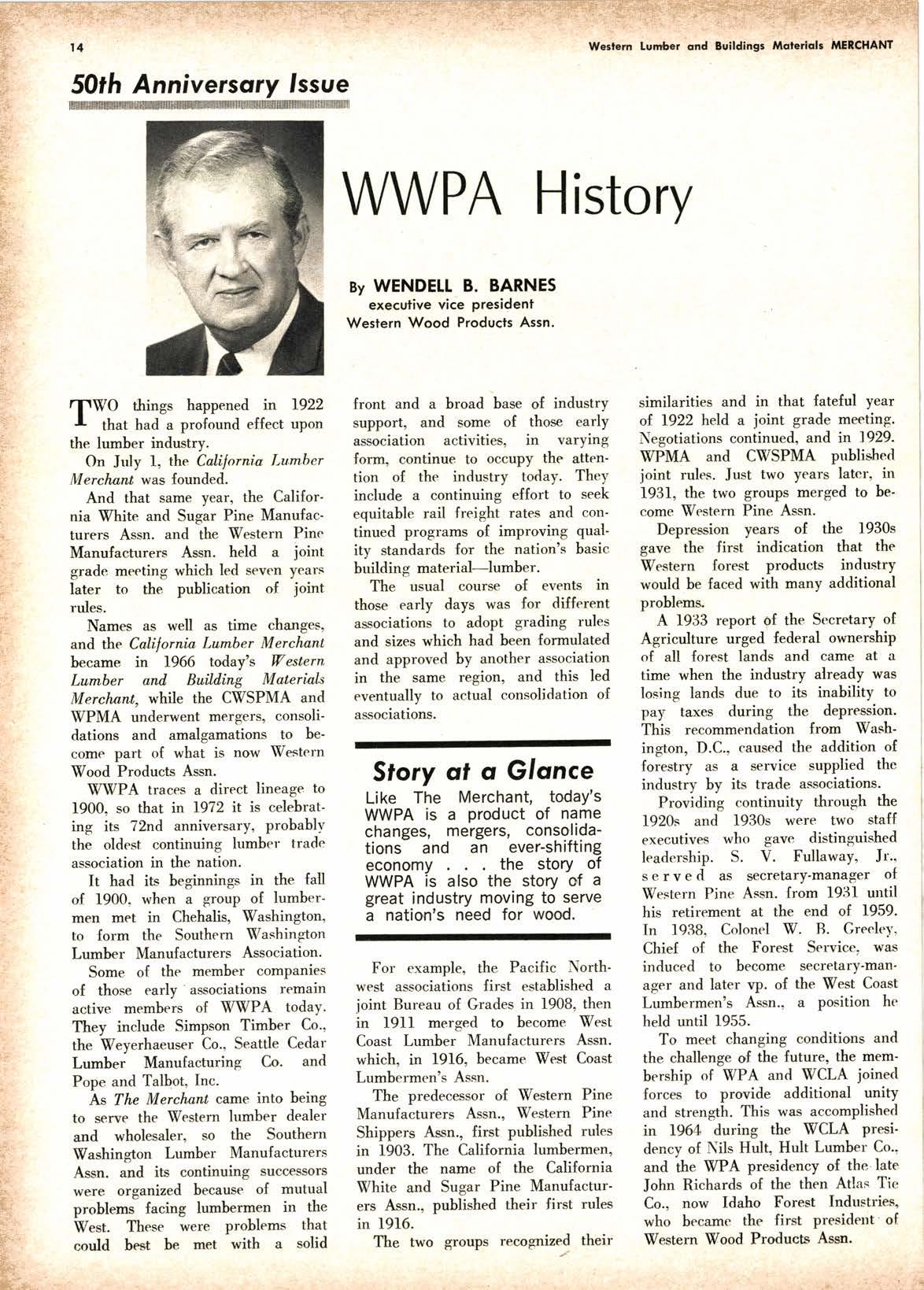
3 minute read
50th Anniversqry lssue WWPA History
By WENDEII B. BARNES execufive vice president Western Wood Producls Assn.
WO things happened in 1922 that had a profound effect upon the lumber industrv.
On July l, the Calilorni.a I'ulnher Merclwnt was founded.
And that same year, the Califor' nia White antl Sugar Pine Manufac' turers Assn. and the Western Pine Manufacturers Assn. held a joint grade meeting which led seven years later to the publication of ioint rules.
Names as well as time changes, and the Calilornia Lumber Merch,ant became in 1966 today's Western Lurnber and, Buililing Materials Merclwnt, while the CWSPMA ancl WPMA underwent mergers' consolidations and amalgamations to be' come part of what is now Western Wood Products Assn.
WWPA traces a direct lineage to 1900, so that in L972 it is celebrat' ing its ?2nd anniversary, probably the oldest continuing lumber trade association in the nation.
It hatl its beginnings in the fall of 1900, when a group of Iumbermen met in Chehalis, Washington, to form the Southern Washington Lumber Manufacturers Assoeiation.
Some of the member comPanies of those early 'as.sociations remain active members of WWPA todaY. They include Simpson Timber Co., the Weyerhaeuser Co., Seattle Cedar Lumber Manufacturing C,o. and Pope and Tal\ot, Inc.
As The Merchant came into being to serye the 'Western lumber dealer and wholesaler, so the Southern Washington Lumber Manufacturers Assn. and its continuing successors were organized because of mutual problems facing lumbermen in the West. These were Problems that could beet be met with a solid front and a broad base of industrY support, and some of thoae early association activities, in varying form, continue to occupy the atten' tion of the industry today. TheY include a continuing effort to seek equitable rail freight rates and continued programs of improving qual' ity standards for the nation's basic building material--lumber.
The usual course of events in those early days was for different associations to adopt grading rules and sizes which had been formulated and approved by another association in the same region, and this led eventually to actual consolidation of associations.
Story sl s Glqnce
Like The Merchant, todaY's WWPA is a product of name changes, mergers, consolidations and an ever-shifting economy the story of WWPA ls also the story of a great industry moving to serve a nation's need for wood.
For example, the Pacific Northwest as-sociations first established a joint Bureau of Grades in 1908, then in IgIl merged to become 'West Coast Lumber Manufacturers Assn. which, in 1916, beeame West Coast Lumbermen's Assn.
The predecessor of W'estern Pine Manufacturers Assn,, Western Pine Shippers Assn., first published rules in 1903. The California lumbermen, under the name of the California White and Sugar Pine Manufactur' ers Assn,, published their first rules in 1916.
The two groups recognized their similarities and in that fateful year oJ L922 held a joint grade meeting. Negotiations continued, and in 1929. WPMA and CWSPMA publishetl joint rules. Just two years later, in 193I, the two groups merged to be' come Western Pine Assn.
Depre.ssion years of the 1930s gave the first indication that the Western forest products industrY would be faced with many additional proble.ms.
A 1933 report of the SecretarY of Agriculture urged federal ownership of all forest lands and came at a time when the industry already was losing lands due to its inability to pay taxes during the dePression. This recommendation from Washington, D.C., caused the addition of forestry as a service supplied the industry by its trade associations.
Providing continuity through the 1920s and 1930s were two staff executives wbo gave distinguished leadership. S. V. FullawaY, Jr.. servetl as secretary-manager of Western Pine Assn. from 1931 until his retire.ment at the end of 1959. In 1938, Colonel W. B. Greelt'Y, Chief of the Forest Service, was induced to become secretary'manager and later vp. of the West Coast Lumbermenos Assn., a position he held until 1955.
To meet changing conditions antl the challenge of the future, the mem' bership of WPA and WCLA joined forces to provide additional unity and strength. This was accomplished in 1964 during the WCLA Presi dency of Nils Hult, Hult Lumber Co., and the WPA presidency of the late John Richards of the then Atlas Tie Co., now Idaho Forest Industries, who became the first president of Western Wood Producls Assn.










